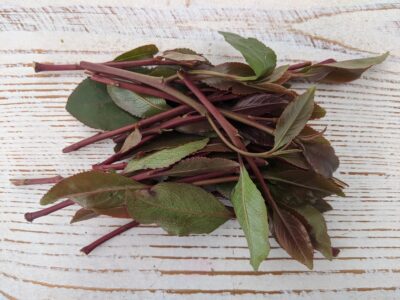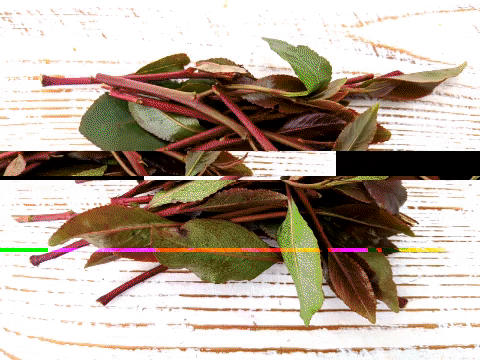Khat (Catha edulis) is a stimulant or “upper,” a substance that wakes one up, but doesn’t effect any changes in perception. Long before the first coffee was ever brewed, humans have been chewing khat as an inebriant, stimulant, and euphoriant.
It is also known as:
- Kafta
- Jimaa
- Miraa
- Muhulo
- Muirungi
- Somali tea
- Arabian tea
- Abyssinian tea
- Flower of paradise
- Bushman’s tea (in South Africa)
- Cat, cath, chat, gat, ghat, jaad, jât, kat, kath, qaad, qaat, qât, qhat, quatt, etc.
Traditional uses
Khat has a role in maintaining social dynamics and it functions much like the coffee we drink in the West – to help stay alert. It is used in socially integrative ritual circles, in parties, and in other social gatherings.
For example, in Yemen, where chewing khat is very common, people meet regularly to chew khat together in the afternoon to reduce fatigue and hunger. While in the past only elders chewed it to stay awake during religious rites, today it is chewed by men and women of all ages.
Medicinally, it is (or was) used for digestive problems, for depression and melancholy, as an appetite suppressant, for headaches, for influenza, asthma, fever, and diseases of the chest, as an aphrodisiac, for gonorrhea, for protection against malaria. It may even have cholesterol-lowering and anti-diabetic effects.
Khat was often used as an aid to remain awake during meditation and prayer. The Sufis and the wandering dervishes in particular regarded the ingestion of the leaves as a sacred activity and used khat to achieve mystical experiences and to attain a sense of union with God.
Khat is also used in drinks. A stimulating drink was made from roasted khat leaves and fresh or dried khat twigs are added to tea for flavor to this day in Yemen.
In Ethiopia, a mild psychoactive mead is made by fermenting a khat infusion with honey.
In Ancient Egypt, khat was regarded as a sacred plant and may have been known as “food of the gods,” “divine food,” or “food of existence” and used for magical, mystical, and spiritual purposes.
In Ancient Greece, khat may had been the magical medicine Alexander the Great used to treat his troops.
Nepenthes (“consoling plant”), a remedy which Homer praises in the Odyssey, has been identified as khat.
Khat leaves were used as a psychoactive incense. In fact, the smoke of Delphi has been attributed to khat leaves.
At the beginning of the twentieth century, invigorating drinks, pharmaceuticals, and agents of pleasure containing khat were sold in Europe.
Nowadays, many Muslims regard khat as sacred. The dried leaves, which are sometimes ground and formed into balls using a binding agent, are used for energy by pilgrims bound for Mecca.
Cathinone – the Psychoactive Constituent of Khat
The alkaloid responsible for khat’s stimulating effects is cathinone.
There is approximately 0.9 mg of this amphetamine-like substance in a fresh leaf.
Because cathinone is a hydrophobic molecule, it can easily cross cell membranes and other barriers, including the blood-brain barrier.
Cathinone is some three times less toxic than amphetamine. It is a cardiac stimulant and is chemically similar to ephedrine. It stimulates the release of dopamine and inhibits the reuptake of epinephrine, norepinephrine, and serotonin in the brain.
Cathinone is not very stable and breaks down to produce cathine and norephedrine, which is why it must be chewed fresh as quickly as possible after cultivation. There is more cathinone in younger khat leaves than in older ones.
Cathine, a metabolite of cathinone, is also a central nervous system stimulant, mild euphoriant, and appetite suppressant of the phenethylamine and amphetamine chemical classes. Cathine has approximately 10–14% the potency of amphetamine. It works by triggering the release of epinephrine, norepinephrin, and to a lesser extent dopamine.
Norephedrine, another cathinone metabolite, also induces CNS stimulation, but it is weaker than that of cathinone.
100 gram of fresh khat leaves contains on average
- 36-343 mg cathinone
- 83-120 mg cathine
- 8-47 mg norephedrine
Psychoactive Effects
The primary effect of khat is a state of arousal characterized by an increase in energy, alertness, concentration, confidence, and wakefulness, which often begins with a tingling sensation on the head and diminishes after about 2 hours. Some have compared it to a combination of the effects of caffeine and morphine.
Sufis and dervishes use it to induce an ecstatic state, but for that a great intention is said to be required as well as proper set and setting.
Some other characteristics of khat inebriation include:
- a general state of well-being, pleasure, a cheerful mood, gaiety, excitement, and euphoria
- manic behaviors and hyperactivity, impaired inhibition (similar to alcohol)
- increases the ability to communicate; talkativeness, verbosity, friendliness
- performance-enhancing; problems appear to be more easily dealt with
- by expanding the memory, it may call the forgotten back into mind
- stimulates the fantasy and power of imagination
- the sense of space and time partially disappears
- hunger-suppressing, anorexic effect
- diminishes the desire for sexuality
Khat is relatively safe and not addictive. Adverse effects, which are more common in long-term, chronic use, may include:
- infrequent hallucinations, permanent tooth darkening (of a greenish tinge), susceptibility to ulcers, gum disease, oral cancer, cardiovascular disease (long-term chronic use)
- digestive problems, such as constipation and heartburn
- thought disorder or psychosis in extreme cases
- increased blood pressure and heart rate
- blurred vision and dilated pupils
- undernourishment
- stroke and death
- urine retention
- nervousness
- depression
- dry mouth
- irritability
- insomnia
- insanity
- mild to moderate psychological dependence (less than tobacco or alcohol). Withdrawal symptoms include hot flashes, lethargy, and a great urge to use the drug for at least the first two days.
How does Khat affect Dreams? Catha edulis Dreams
Khat’s withdrawal symptoms include vivid dreams, sometimes bad dreams. Hypersomnia (excessive daytime sleepiness) is another side effect of withdrawal. This makes the withdrawal phase, and to a lesser extent the aftereffects, of khat potentially a good time to engage in lucid dreaming.
One person reported after chewing khat leaves:
I tried to keep the Khat in my cheek, but ended up having to spit it out. By this time, it was around 6pm in the evening […] After spitting out my Khat, I felt queasy and did not enjoy the physical effort it took to walk clear across town. When I got back I laid down, and this feeling quickly passed. Despite everyone warning me of insomnia, I fell asleep with no trouble, and had wonderfully lucid dreams.
The acute phase of the inebriation for some people may also involve a heightened sense of daydreaming, like in the following report by a person who ingested 100 grams of khat:
I would describe the experience as: lucid, slight corner-of-the-eye or closed eye visuals, energetic, cheerful. At this higher dose there was definitely a stronger dream-like aspect to it as well.
Indeed, khat-induced hypnagogic hallucinations in chronic users are apparently a thing, as described in a 1988 article from Acta Psychiatrica Scandinavica, a Scandinavian peer-reviewed medical journal:
a substantial number of chronic khat chewers experience persistent hypnagogic hallucinations – a symptom that has not yet been described. Three vignettes illustrates this phenomena, which often interferes with psychiatric diagnosis. Different explanatory models are discussed, among them chronic suppression of REM sleep.
It is possible that khat suppresses not just sleep, but REM sleep in particular. When REM sleep is chronically suppressed, eventually dreams will start creeping up during waking.

How to Use
The young leaves, twigs (the ends of the branches), and leaf buds are psychoactive.
The fresh leaves have a higher concentration of cathinone, which quickly breaks down into its less potent form, cathine.
Leaves that have been damaged by frost should not be used as they are said to cause headaches.
To preserve khat, freeze the fresh leaves.
Chewing (Buccal administration)
The most common method of consuming khat is to chew the fresh leaves. They should be chewed as soon after harvesting as possible (and not later than 2 days).
The active ingredients are absorbed through the cheek and gum at first, and after the juices are swallowed, cathine and cathinone are absorbed through the lining of the stomach.
Oral dose: 100-200 grams of leaves (though Ethiopian khat farmers are said to eat up to 750 grams to start their day).
Simply take as many of the leaves into the mouth as possible, then chew them for some ten minutes before either spitting them out or swallowing them. Swallow the juice of the chewed leaves periodically. The longer the juice is retained in the mouth, the more pronounced the effects. Drink a lot of water during the chewing.
Other Ways to Orally Consume Khat
Perhaps the most effective way to take khat, is to drink the extracted juice of the fresh leaves. In Yemen fresh leaves are pounded in mortars, but for most of us, it would probably be easier to use a juicer or blender. (If using a blender, you will need to strain the juice from the pulp after blending.)
The fresh leaves and branch tips are (more rarely) brewed or boiled into a tea.
They also can be ground, mixed with sugar, and made into candies.
In Somalia, the leaves are sometimes dried in the sun and then crushed. Cardamom, cloves, and water are then mixed with the powder to produce a paste that is taken as a quid.
The leaves or the soft part of the stem can be chewed with either chewing gum or fried peanuts to make it easier to chew.
Dried leaves can also be mixed with water to prepare a paste for ingestion by old people without teeth.
In Israel a cocktail is made with the following ingredients:
- Arak
- minced frozen khat
- grapefruit juice
Smoking Khat
While the main psychoactive component, cathinone, decomposes rapidly to the milder chemical, cathine, when the materiel is dried, khat leaves may be also be smoked.

In Yemen, dried leaves are smoked both alone and with other substances, especially hashish (Cannabis). It is said that tobacco should be smoked along with khat as it will potentiate the effects of the khat.
Dried leaves that are still green are used as a medicinal incense.
Procuring Khat
White (ahde) khat is green, while the leaves of red (dimma) khat have a red hue.
Red khat is more potent.
Leaves from khat bushes grown in the US and Europe have been found to contain little or almost no alkaloids so it may be best to get from Africa (countries such as Somalia, Yemen, Ethiopia or Kenya).
kudda / giza – first quality
uretta – second quality
kerti / kangeta – third quality
The average price for 50 grams of khat is $10.
Khat is a controlled or illegal substance in many countries, including the United States of America.



Perhaps the problem is that like with cocaine, when leaves are chewed, the plant is pretty harmless, but when an extract is made of it, and it’s very easy to press khat into a juice and drink it, it may become dangerous and toxic. You cannot die from cannabis, but you can definitely die from an overdose of khat. This is why in Israel for example where many people have a tradition of chewing khat leaves, extracting juice from it recently became illegal.
I’m curious as to why it was banned in the U.S. Was it racially motivated as was the case with other drugs like Marijuana?